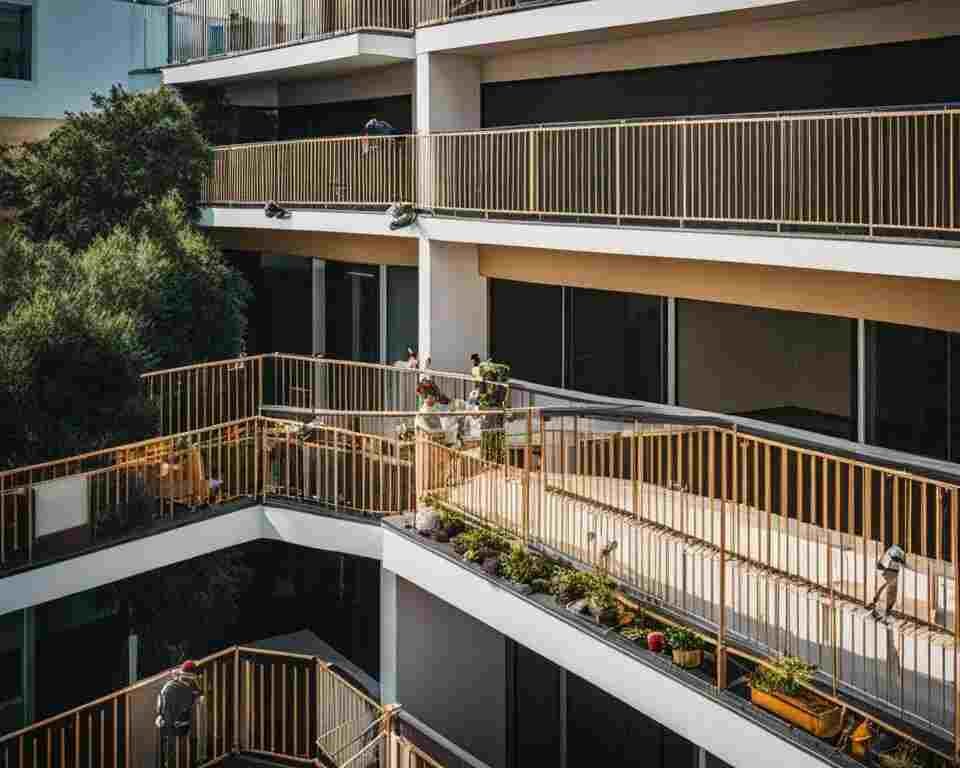As an enthusiastic hot tub lover, I’ve always been intrigued by the idea of having an inflatable hot tub on my balcony. However, before taking the plunge, so to speak, I wanted to explore the safety concerns associated with such a setup.
Placing an inflatable hot tub on a balcony may seem like a convenient and luxurious solution, but it’s crucial to consider the potential risks and safety implications. Balcony safety concerns include factors such as weight limits, proper ventilation, and the impact on the flooring.
Key Takeaways:
- Placing an inflatable hot tub on a balcony requires careful consideration of safety concerns.
- Balcony weight limits and proper ventilation are crucial factors to assess before installing a hot tub.
- It’s important to evaluate the impact of an inflatable hot tub on the balcony’s flooring.
- Measuring balcony space and assessing construction and support are essential considerations.
- It’s crucial to evaluate the risks by calculating the total weight and seeking professional assessments.

Understanding Balcony Safety Concerns
Placing an inflatable hot tub on a balcony comes with its set of safety concerns that must be carefully considered. In this section, we will delve into these concerns, addressing the weight limit for the balcony, ensuring proper ventilation, and understanding the impact of inflatable hot tubs on balcony flooring.
Weight Limit for Balcony: Can It Handle the Pressure?
The weight limit of your balcony is a crucial factor to consider when installing an inflatable hot tub. Exceeding the weight limit can lead to structural damage and compromise the safety of your balcony. To determine if your balcony can handle the pressure, consider factors such as the construction materials, load-bearing capacity, and any restrictions outlined by your building’s guidelines or regulations. It is recommended to consult a structural engineer to assess the weight-bearing capacity of your balcony and ensure it can safely support a hot tub.
Ensuring Proper Ventilation on Your Balcony
Proper ventilation is essential when installing an inflatable hot tub on a balcony. Without adequate airflow, excess moisture and humidity generated by the hot tub can accumulate, leading to potential damage not only to your balcony but also to the surrounding structures. Ensure that there is sufficient airflow around the hot tub, allowing moisture to evaporate and preventing the growth of mold or mildew. This can be achieved by leaving open spaces or installing vents on the balcony walls or floor.
Impact of Inflatable Hot Tubs on Balcony Flooring
The weight and constant presence of an inflatable hot tub can have an impact on the balcony flooring. The pressure exerted by the tub, combined with the weight of water and occupants, can cause indentation, cracking, or even collapse of the flooring. To mitigate the risk of damage, it is advisable to reinforce the flooring or use protective measures such as laying down a sturdy, cushioned mat beneath the hot tub. Additionally, regular inspections and maintenance of the flooring are essential to ensure its structural integrity and address any signs of wear or damage promptly.

Can I Put an Inflatable Hot Tub on My Balcony
The question of whether it is possible to put an inflatable hot tub on a balcony is a common one. Many people are drawn to the idea of having a hot tub on their balcony, but they want to ensure that it is safe and feasible. The answer to this question ultimately depends on a few key factors that need to be considered.
First and foremost, it is important to assess the weight limit of your balcony. Balconies have specific weight restrictions that determine how much weight they can safely hold. Placing an inflatable hot tub adds additional weight to the balcony, so it is crucial to ensure that the structure is capable of handling the pressure.
Proper ventilation is another important aspect to consider when installing a hot tub on a balcony. Hot tubs release steam and heat, which can potentially lead to issues if there is inadequate airflow. Proper ventilation helps to prevent moisture buildup and protect the balcony against any potential damage.
The impact of an inflatable hot tub on the flooring of your balcony is also worth noting. Some hot tubs may be heavier than others, and certain balcony flooring materials may not be able to withstand the weight. It is essential to evaluate the durability of the flooring and determine if any modifications or reinforcements are needed to support the hot tub securely.
While it is possible to put an inflatable hot tub on a balcony, it is crucial to ensure that certain criteria are met. This includes assessing the weight limit of the balcony, maintaining proper ventilation, and considering the impact on the balcony flooring. By carefully evaluating these factors, you can make an informed decision about whether or not it is feasible to install a hot tub on your balcony.

Key Considerations Before Installing a Hot Tub
Before installing a hot tub on your balcony, it is essential to carefully consider several key factors. These considerations will help ensure that your balcony is suitable for supporting the weight of the hot tub and that it can accommodate the necessary space requirements. By assessing these aspects beforehand, you can make an informed decision and create a safe and enjoyable hot tub experience on your balcony.
Measuring Balcony Space for Your Inflatable Hot Tub
One of the first steps in preparing your balcony for a hot tub is accurately measuring the available space. Inflatable hot tubs come in various sizes, so it’s crucial to determine whether your balcony can accommodate the dimensions of the hot tub you have in mind. Measure the length, width, and height of your balcony to ensure there is enough space for the inflated hot tub, as well as any necessary clearance for easy access and maintenance.
In addition to the overall size, consider the weight-bearing capacity of your balcony when selecting an inflatable hot tub. Each balcony has different load-bearing limitations, and exceeding these limits can lead to structural damage and safety hazards. Contact your building’s management or consult a structural engineer to determine the weight capacity of your balcony and select an inflatable hot tub that falls within the recommended limits.
Assessing Balcony Construction and Support
Inspect the materials, such as concrete or metal, that your balcony is constructed from to ensure they are capable of supporting the added weight. If you have any doubts about the structural integrity of your balcony, it is essential to consult a structural engineer before installing a hot tub.
Assess the support system of your balcony, including the railing and any additional support beams or pillars. These elements contribute to the overall stability of your balcony and should be strong enough to withstand the additional load imposed by an inflatable hot tub.
By taking these key considerations into account, you can ensure that your balcony is suitable for installing a hot tub. Measuring the balcony space accurately and assessing the construction and support will help you make an informed decision and prioritize safety when enjoying your inflatable hot tub on the balcony.
Evaluating the Risks: Balcony Load Capacity vs. Hot Tub Weight
When considering placing an inflatable hot tub on a balcony, it is crucial to evaluate the potential risks involved. One of the key factors to assess is the balcony’s load capacity in comparison to the weight of the hot tub.
Calculating the Total Weight of an Inflatable Hot Tub Setup
In order to determine if your balcony can safely support the weight of an inflatable hot tub, you must calculate the total weight of the setup. This includes not only the weight of the hot tub itself but also the weight of the water, people, and any accessories or additional equipment you plan to use.
Start by finding the specifications of your hot tub, which should indicate its weight when empty. Next, estimate the weight of the water that will fill the tub. On average, each gallon of water weighs around 8.34 pounds (3.78 kg). Multiply the capacity of the hot tub by this weight per gallon to find the total water weight.
Additionally, consider the weight of the people who will be using the hot tub. Keep in mind that the weight distribution may not be uniform, so it’s wise to account for the maximum weight of multiple individuals to err on the side of caution.

Professional Assessment: Consulting a Structural Engineer
While you can estimate the weight of the hot tub setup on your own, it is highly recommended to seek a professional assessment from a structural engineer. A qualified engineer will have the expertise to thoroughly evaluate your balcony’s load capacity and suitability for supporting an inflatable hot tub.
A structural engineer will consider various factors such as the balcony’s materials, construction methods, and existing load-bearing capabilities. They will have a deeper understanding of the structural integrity and can provide valuable insights and recommendations to ensure the safety of your installation.
By consulting a structural engineer, you can have peace of mind knowing that you have received a professional evaluation of the risks involved and that you are making an informed decision regarding the installation of an inflatable hot tub on your balcony.
Navigating Balcony Regulations and Restrictions
When considering placing an inflatable hot tub on your balcony, it is essential to understand the regulations and restrictions that may apply. Balcony regulations vary depending on the building and local authorities, and it is crucial to comply with these guidelines to ensure the safety and well-being of yourself and others.
Understanding Your Building’s Balcony Guidelines
Each building may have its own set of balcony guidelines in place to maintain the structural integrity of the property and ensure the safety of its residents. These guidelines often include restrictions on the weight, size, and placement of items on the balcony.
Before installing an inflatable hot tub, it is essential to consult your building’s management or homeowner’s association to understand the specific rules and limitations that apply to your balcony. This will help you determine whether your balcony can accommodate the weight of the hot tub and if any additional modifications or permissions are required.
Insurance and Liability: Protecting Your Property
Some insurance policies may have specific requirements or exclusions regarding the installation of large items, such as hot tubs, on balconies. It is advisable to inform your insurance provider about your plans and ensure you have adequate coverage in place.
Furthermore, liability issues may arise if the hot tub causes damage to other properties or injuries to individuals. Understanding your legal responsibilities and taking necessary precautions, such as proper installation and maintenance, can help mitigate potential liability risks.
Balancing Aesthetics and Safety: Proper Installation Tips
When installing an inflatable hot tub on a balcony, it’s essential to strike a balance between aesthetics and safety. While you want your hot tub to enhance the visual appeal of your outdoor space, it’s crucial to ensure that the installation is done correctly to prioritize safety. Here are some proper installation tips:
Choosing the Right Inflatable Hot Tub for Your Space
Before purchasing an inflatable hot tub, consider the size and weight capacity of your balcony. Measure the available space to determine the dimensions of the hot tub that will fit comfortably. Be mindful of the weight limit specified by the manufacturer. You want to select a hot tub that not only suits your aesthetic preferences but also adheres to the safety requirements of your balcony.
Incorporating Safety Features and Accessories
Enhance the safety of your inflatable hot tub installation by incorporating suitable safety features and accessories. Consider adding a non-slip mat or flooring around the hot tub to prevent slips and falls. Install handrails or guardrails to provide additional support and stability. If your balcony has a railing, ensure it is secure and meets safety standards. Additionally, consider investing in a cover and lock to prevent unauthorized access and ensure the safety of children or pets.
By carefully selecting the right inflatable hot tub for your balcony and incorporating the necessary safety features and accessories, you can create a space that is both visually appealing and safe. Prioritizing safety during the installation process will allow you to enjoy your hot tub with peace of mind.
Conclusion
In conclusion, the decision to put an inflatable hot tub on a balcony requires careful consideration of several factors. Throughout this article, we have explored the various safety concerns and considerations associated with this installation.
First and foremost, it is essential to understand the weight limit of your balcony and evaluate whether it can withstand the pressure exerted by a hot tub. Proper ventilation on the balcony is crucial to prevent moisture damage and mold growth. Additionally, the impact of the hot tub on the balcony’s flooring should not be overlooked.
Before proceeding with the installation, it is advisable to measure your balcony space and ensure it can accommodate the hot tub. The construction and support of the balcony should also be assessed to ensure it can safely bear the weight of the hot tub and its occupants.
Evaluating the risks involves calculating the total weight of the hot tub setup and considering a professional assessment from a structural engineer. This ensures that the installation meets safety standards and minimizes the risk of structural damage.
Moreover, it is important to familiarize yourself with any regulations and restrictions that apply to your balcony. Understanding your building’s balcony guidelines and complying with insurance and liability requirements will help protect your property and avoid any penalties.
By carefully balancing aesthetics and safety during the installation process, you can enhance the overall enjoyment and peace of mind when using an inflatable hot tub on your balcony. Choosing the right hot tub for your space and incorporating safety features and accessories further contributes to a safer and more enjoyable experience.
In conclusion, while it is possible to put an inflatable hot tub on a balcony, it is essential to prioritize safety and consider all the aforementioned factors. By taking the necessary precautions and ensuring compliance with regulations and guidelines, you can enjoy the benefits of a hot tub while minimizing any potential risks.

